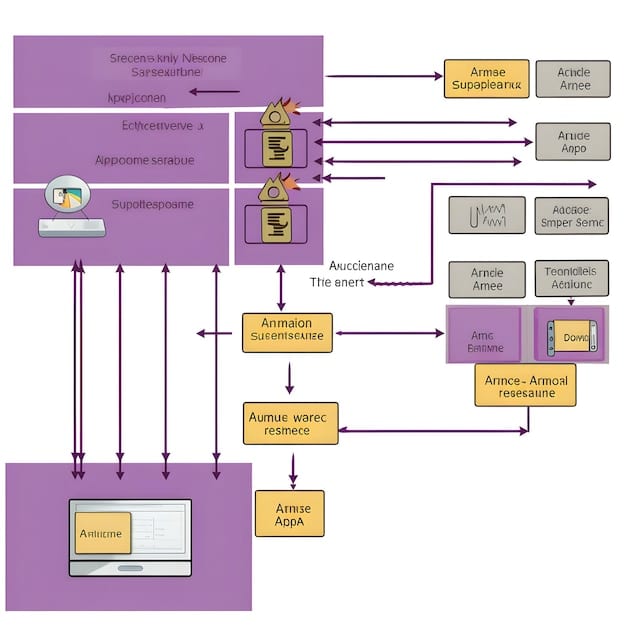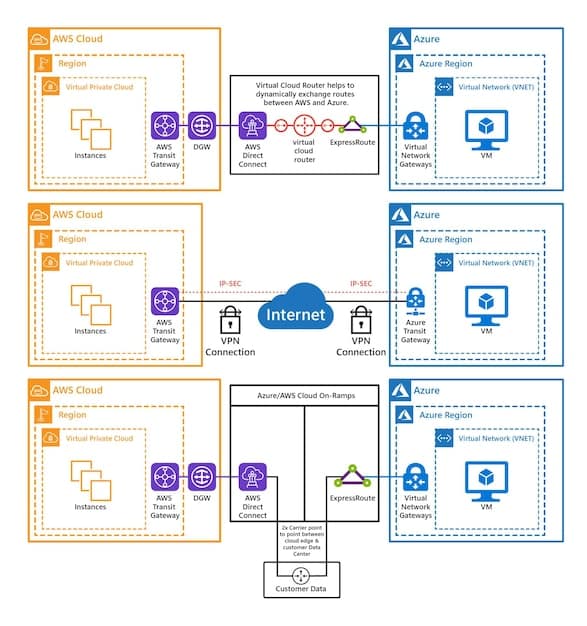Implementing Microservices Architecture with .NET Core: A US Developer’s Guide

Implementing Microservices Architecture with .NET Core for US Developers involves structuring an application as a collection of small, autonomous services, modeled around a business domain, and leveraging .NET Core’s capabilities for building cross-platform, high-performance applications.
Ready to dive into implementing Microservices Architecture with .NET Core: A Detailed Tutorial for US Developers? This guide will walk you through the essential steps to build robust, scalable applications from the ground up, tailored for the US development landscape.
Understanding Microservices Architecture with .NET Core
Microservices architecture has transformed how applications are built, especially in complex systems. It’s about breaking down a monolithic application into smaller, manageable services.
For US developers, understanding the core principles of microservices and how .NET Core supports them is crucial for building scalable and maintainable applications.
Key Principles of Microservices
Microservices are characterized by several key principles that distinguish them from traditional monolithic applications.
- Single Responsibility: Each microservice should have a single, well-defined responsibility.
- Autonomy: Microservices should be independent and deployable without affecting other services.
- Decentralization: Embrace decentralized governance, data management, and technology choices.
- Fault Isolation: Failures in one microservice should not cascade to other services.
By adhering to these principles, developers can create systems that are more resilient, scalable, and easier to evolve.

The shift to microservices enables teams to work independently on different parts of the application, reducing coordination overhead and accelerating development cycles.
Setting Up Your .NET Core Environment
Before diving into microservices implementation, ensuring a properly configured .NET Core environment is essential. This involves installing the .NET Core SDK and setting up your development tools.
For US developers, having a robust and optimized development environment is the first step toward a successful microservices project.
Installing the .NET Core SDK
The .NET Core SDK provides the necessary tools and libraries to build, test, and deploy .NET Core applications. It’s available for Windows, macOS, and Linux.
- Download the latest version of the .NET Core SDK from the official Microsoft website.
- Follow the installation instructions for your operating system.
- Verify the installation by running
dotnet --versionin your terminal or command prompt.
Once installed, the SDK provides access to the .NET CLI, which is used for creating, building, and running .NET Core projects.
Choosing Your Development Tools
Selecting the right development tools can significantly impact your productivity. Popular options include:
- Visual Studio: A comprehensive IDE with rich features for .NET development.
- Visual Studio Code: A lightweight and cross-platform editor with excellent .NET Core support through extensions.
- JetBrains Rider: A cross-platform .NET IDE known for its advanced code analysis and refactoring capabilities.
Choose the tool that best fits your workflow and project requirements.
Configuring your environment properly ensures a smooth development experience, setting the foundation for building microservices with .NET Core.
Designing Microservices: Key Considerations
Designing microservices requires a different mindset compared to monolithic applications. It involves careful planning to ensure each service is independent, scalable, and maintainable.
For US developers, understanding these design considerations is critical for building effective microservices architectures.
Domain-Driven Design (DDD)
Domain-Driven Design (DDD) is a software development approach that focuses on aligning software design with the business domain. DDD principles are highly relevant when designing microservices.
DDD helps in identifying bounded contexts, which represent specific areas of the business domain. Each microservice can then be designed around a bounded context, ensuring it encapsulates a specific set of functionalities.
Communication Patterns
Microservices communicate with each other to fulfill business requirements. Common communication patterns include:
- Synchronous Communication: Using HTTP-based REST APIs for request-response interactions.
- Asynchronous Communication: Using message queues (e.g., RabbitMQ, Azure Service Bus) for event-driven interactions.
The choice of communication pattern depends on the specific requirements of each microservice interaction. Asynchronous communication is often preferred for decoupling services and improving scalability.

Data Management
Data management in a microservices architecture is decentralized. Each microservice should own its data and be responsible for managing it.
Common strategies for data management include:
- Database per Service: Each microservice has its dedicated database.
- Shared Database: Multiple microservices share the same database, but own different schemas or tables.
The database per service pattern is generally preferred for ensuring loose coupling and autonomy between microservices.
Careful design considerations are essential for creating a well-structured and effective microservices architecture.
Building Your First Microservice with .NET Core
Now, let’s dive into the practical aspects of building a microservice using .NET Core. We’ll create a simple service that demonstrates the fundamental concepts.
This tutorial provides a step-by-step guide for US developers to build their first .NET Core microservice.
Creating a New .NET Core Project
Use the .NET CLI to create a new ASP.NET Core Web API project:
dotnet new webapi -n MyMicroserviceThis command creates a new directory named MyMicroservice with the necessary files for a Web API project.
Defining Endpoints
Define the API endpoints that your microservice will expose. For example, you can create a simple endpoint that returns a greeting:
[ApiController]
[Route("[controller]")]
public class GreetingController : ControllerBase
{
[HttpGet]
public string Get()
{
return "Hello from MyMicroservice!";
}
}
This code defines a GreetingController with a Get method that returns a simple greeting.
Running Your Microservice
Navigate to the project directory and run the microservice using the .NET CLI:
cd MyMicroservice
dotnet runThis starts the microservice, and you can access the greeting endpoint by navigating to http://localhost:5000/greeting in your browser.
Congratulations, you’ve built your first .NET Core microservice! This simple example demonstrates the basic steps involved in creating and running a microservice.
Communication Between Microservices
Microservices often need to communicate with each other to perform complex tasks. Implementing effective communication patterns is crucial for a well-functioning microservices architecture.
For US developers, mastering these communication techniques is essential for building robust and scalable microservices.
REST API Communication
RESTful APIs are a common way for microservices to communicate synchronously. .NET Core provides excellent support for building and consuming REST APIs.
To make a REST API call from one microservice to another, you can use the HttpClient class:
using System.Net.Http;
using System.Threading.Tasks;
public class MyService
{
private readonly HttpClient _httpClient;
public MyService(HttpClient httpClient)
{
_httpClient = httpClient;
}
public async Task GetDataFromAnotherService()
{
var response = await _httpClient.GetAsync("http://another-service/api/data");
response.EnsureSuccessStatusCode();
return await response.Content.ReadAsStringAsync();
}
}
This code demonstrates how to use HttpClient to make a GET request to another microservice and retrieve data.
Message Queue Communication
Message queues enable asynchronous communication between microservices. Common message queue technologies include RabbitMQ and Azure Service Bus.
To send a message to a queue, you can use a .NET client library for the specific message queue technology:
using RabbitMQ.Client;
using System.Text;
public class MessagePublisher
{
public void PublishMessage(string message)
{
var factory = new ConnectionFactory() { HostName = "localhost" };
using (var connection = factory.CreateConnection())
using (var channel = connection.CreateModel())
{
channel.QueueDeclare(queue: "myqueue", durable: false, exclusive: false, autoDelete: false, arguments: null);
var body = Encoding.UTF8.GetBytes(message);
channel.BasicPublish(exchange: "", routingKey: "myqueue", basicProperties: null, body: body);
}
}
}
This code demonstrates how to publish a message to a RabbitMQ queue. Another microservice can then consume this message to perform its task.
Effective communication patterns are essential for ensuring that microservices can work together seamlessly to deliver business value.
Testing and Deployment Strategies
Testing and deployment are critical aspects of microservices architectures. Implementing robust testing strategies and streamlined deployment pipelines is essential for ensuring the reliability and scalability of your services.
For US developers, adopting best practices for testing and deployment can significantly improve the quality and speed of delivery of microservices-based applications.
Unit Testing
Unit testing involves testing individual components or units of code in isolation. It’s a fundamental part of the testing process.
.NET Core provides excellent support for unit testing through frameworks like xUnit and NUnit. Here’s an example of a simple unit test:
using Xunit;
public class MyServiceTests
{
[Fact]
public void GetData_ReturnsCorrectData()
{
var service = new MyService();
var result = service.GetData();
Assert.Equal("Expected Data", result);
}
}
Integration Testing
Integration testing involves testing the interactions between different microservices or components. It ensures that the services work together correctly.
Tools like Docker and Docker Compose can be used to set up test environments for integration testing.
- Automated Testing: Set up automated test suites that run as part of your CI/CD pipeline.
- Contract Testing: Use contract testing to ensure that microservices adhere to their defined contracts.
Deployment Strategies
Choosing the right deployment strategy is crucial for minimizing downtime and ensuring a smooth deployment process. Common strategies include:
- Rolling Deployments: Gradually deploy new versions of the microservice while the old versions are still running.
- Blue-Green Deployments: Deploy the new version of the microservice to a separate environment (the “blue” environment) and switch traffic to it once it’s verified.
Implementing robust testing and deployment strategies ensures that your microservices-based applications are reliable, scalable, and easy to maintain.
| Key Aspect | Brief Description |
|---|---|
| 🛠️ Microservices Design | Focus on single responsibility, autonomy, and decentralization. |
| 🌐 Communication Patterns | Use REST APIs or message queues (like RabbitMQ) for service interactions. |
| 🧪 Testing Strategies | Implement unit, integration, and contract testing for reliability. |
| 🚀 Deployment | Use rolling or blue-green deployments to minimize downtime. |
Frequently Asked Questions
▼
Microservices architecture is a design approach where an application is structured as a collection of small, autonomous services, modeled around a business domain, promoting scalability and maintainability.
▼
.NET Core is cross-platform, high-performance, and offers great tooling for building modern, scalable applications, making it ideal for microservices development.
▼
Microservices can communicate synchronously via REST APIs or asynchronously through message queues like RabbitMQ or Azure Service Bus, depending on the application’s needs.
▼
Key considerations include domain-driven design (DDD), choosing appropriate communication patterns, and decentralized data management, typically with each service owning its database.
▼
Effective testing involves unit tests for individual components, integration tests to verify service interactions, and contract tests to ensure services adhere to defined interfaces.
Conclusion
In conclusion, implementing Microservices Architecture with .NET Core: A Detailed Tutorial for US Developers provides a pathway to building scalable, maintainable, and robust applications. By understanding the principles, setting up the environment, designing effective services, and implementing robust communication and testing strategies, US developers can leverage .NET Core to create powerful microservices-based applications that meet the demands of modern software development.





